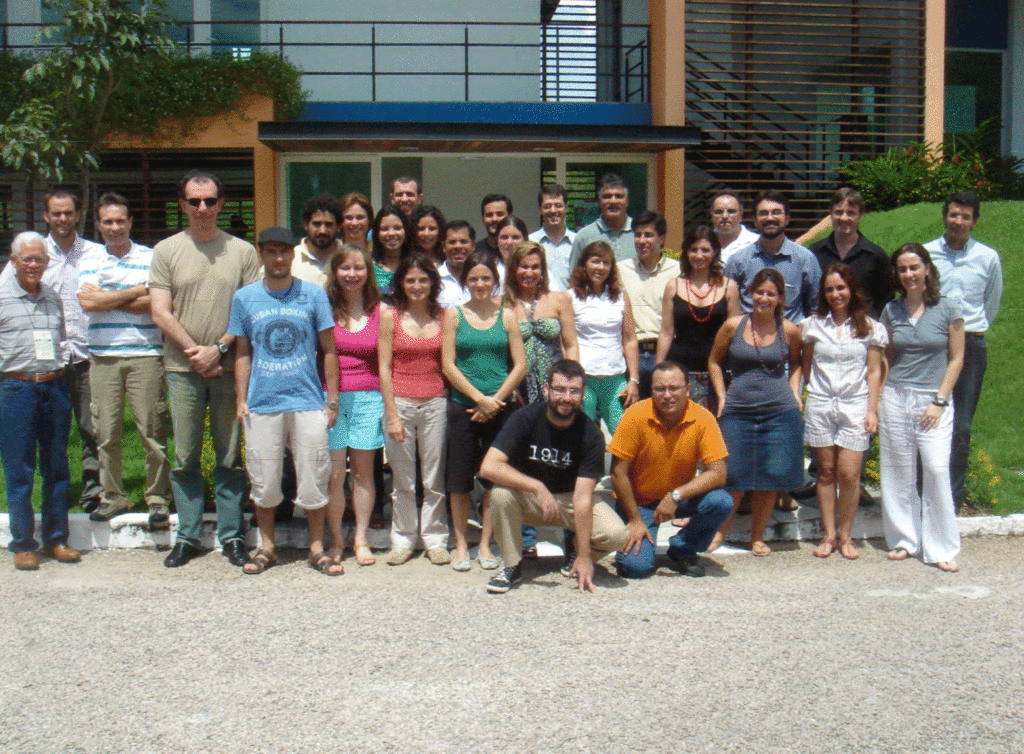20 – 24 April 2009, Natal, Brazil
Objectives Participants Speakers Photos Summary Report
The Training Institute addressed the question how to assess regional water availability and vulnerability of communities in the context of basin hydrology. Water needs for agriculture, irrigation, cities and industry were related to potential changes in watershed function under land cover change.
24 participants from 6 countries in the Americas attended the Training Institute.
Objectives
The main objective of the training institute was to expand our understanding of how remote sensing information can provide information to help assessing the impacts of global change on the hydrology of semi-arid regions based on the example, of time changes in water availability in valleys in response to inter-annual variability of precipitation. Other objectives were: 1) include multidisciplinary approaches in the use of remote sensing of hydrology, including physiographic variables affecting water in the analyses; 2) to provide participants with background information on hydrology and its connections with other environmental and socioeconomic factors; 3) to give background information on remote sensing to encourage participants to widen the application to address information needs; 4) to prepare participants to use research to shape policies for sustainable use of water resources in agriculture and other sectors; 5) to identify sources of remote sensing data; 6) to develop a regional knowledge network to make operational use of remote sensing technology for water management.
Participants
– Carine Antunes Correia Marinho – CHESF
– Celina Santoni – Universidad Nacional de San Luis/CONICET
– Constanza Caride – Universidad de Buenos Aires
– Dolores Lettelier – CONICET
– Eduardo Bustos – Pontificia Universidad Catolica de Chile
– Elke Noellemeyer – Universidad Nacional de La Pampa
– Ethel Rubin de Celis – Universidad Nac Agraria La Molina (UNALM)
– Francisco Rafael Sousa Freitas – Fundação Norte Riograndense de Pesquisa e Cultura (FUNPEC)
– Gustavo Cruz Bello – National Inst Forestry Agr Livestock R.
– Iêdo Bezerra Sá – EMBRAPA Semi-Árido
– Javier Houspanossian – GEA/CONICET
– José Américo Bordini do Amaral – EMBRAPA Agroindústria Trop
– Juliano Schirmbeck – SulSoft/UNICEN-IHLLA
– Katia Arraes – Instituto Nacional de Pesquisas Espaciais (INPE – Natal)
– Lidia Ferri Hidalgo – IANIGLA
– Manuel Rodrigues de Freitas Filho – FUNCEME / Univ.Est. Ceará
– Maria Carolina da Motta Agra – CHESF
– Mariano Oyarzabal – IFEVA
– Mayra Milkovic – IFEVA
– Moira Doyle – Universidad de Buenos Aires/CONICET
– Patrick Debels – Independent Environmental Consultant
– Pierre Pitte – IANIGLA / CONICET
– Raniere Rodrigues Melo de Lima – Federal University of State Rio Grande do Norte (UFRN)
– Raúl Ramirez – Universidad Simón Bolívar
– Thaise Emmanuele Andrade de Sales – Federal University of State Rio Grande do Norte (UFRN)
Speakers
– Arthur Mattos – Universidade Federal do Rio Grande do Norte (UFRN)
– André Lima – Instituto Nacional de Pesquisas Espaciais (INPE)
– Camilo Rennó – Instituto Nacional de Pesquisas Espaciais (INPE)
– Claudia Linhares – Instituto Nacional de Pesquisas Espaciais (INPE)
– Edison Crepani – Instituto Nacional de Pesquisas Espaciais (INPE)
– José Santino – Fundação de Amparo à Pesquisa de Alagoas (FAPEAL)
– Luciano Accioly – Empresa Brasileira de Pesquisa Agropecuária (EMBRAPA)
– Regina Alvala – Instituto Nacional de Pesquisas Espaciais (INPE)
– Roxana Aragón – Universidad de Buenos Aires (UBA)
– Humberto Alves Barbosa – Universidade Federal de Alagoas (UFAL)
– Rômulo Menezes – Universidade Federal de Pernambuco (UFPE)
– Everardo Sampaio – Universidade Federal de Pernambuco (UFPE)
– Vinícius Queiroga Duarte – Companhia Hidro Elétrica do São Francisco (CHESF)
Summary
Vulnerability to water shortage is not only the result of the natural setting, but is also related to shortage of information on changes in space and time of basin hydrology in response to climatic, geological and human factors. In most semi-arid regions there is lack of quality information on natural resources. In order to fill this gap, the training activity focused on the use of remote sensing to obtain crucial hydrological information enabling natural resources managers and local communities to a more efficient use of water.
The training course was customized to look at the relationship between time changes in water availability in the Brazilian semi-arid Northeast for crop production. Agriculture in the semi-arids takes place in valleys with greater water availability. In spite of the importance of those valleys to local economy and food security, there is a complete lack of information on the amount of valley area available for crop. Moreover, there is little information on the inter-annual changes in the moisture retained in those valleys in response to climate, vegetation degradation, diversion or impoundment of water. Taking into account the multidisciplinary nature of the issues that were addressed in the training institute, the course was opened to professionals from different fields, such as agriculture, hydrology, remote sensing, ecology, geography, economics, etc.
In this course, participants were able to learn how to use Shuttle Radar Topographic Mapping mission (SRTM) data to map valleys and compute their extent in different landscapes. They have also learned how to assess seasonal changes in the water availability within the valleys by using time series of soil moisture and vegetation indexes derived from MODIS data, among others.
This IAI Training Institute was an effort to assist policy and decision-makers to take advantage of the available remote sensing technology for obtaining the necessary information to prepare better responses to the challenges of planning environmental control policies to increase food security in semi-arid regions.
Report
Training Institute report:PDF in English

